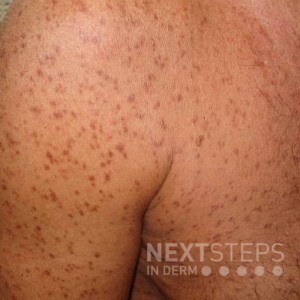
The correct answer is: C. Genitourinary.
The attached image shows numerous tan to red-brown macules and papules, which is indicative of mastocytosis. There are different forms of cutaneous mastocytosis. The most common form is urticaria pigmentosa, which can appear in both children and adults. Diffuse cutaneous mastocytosis occurs almost exclusively in infants. Solitary mastocytoma, and telangiectasia macularis eruptiva perstans represent additional forms of mastocytosis. Systemic involvement occurs most commonly in adults. The genitourinary, and neuroendocrine, systems are least likely to be involved.
The bone marrow, lymph nodes, liver, spleen and GI tract are among the most commonly involved organs in systemic mastocytosis.
References:
Pardanani A. Systemic mastocytosis in adults: 2015 update on diagnosis, risk stratification, and management. Am J Hematol. 2015 Mar;90(3):250-62. PubMed Link: https://www.ncbi.nlm.nih.gov/pubmed/25688753.
